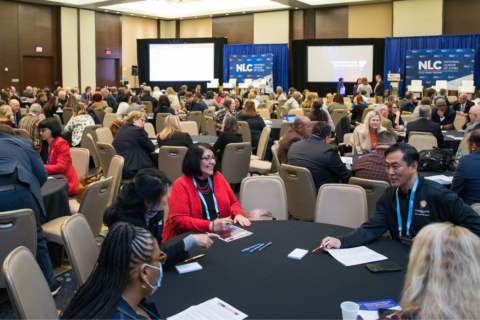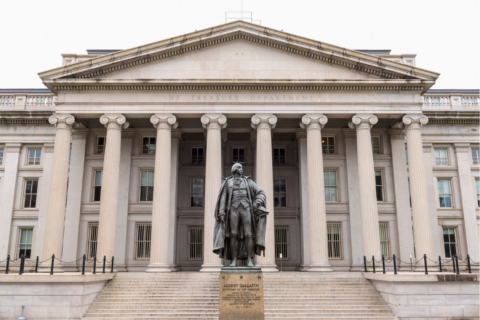On August 10, 2023, the U.S. Department of Treasury released its long awaited Interim Final Rule on ARPA Flex. For more details on the final rule, click here.
Except as otherwise determined by the Secretary, the use of SLFRF funds for Surface Transportation and Title I projects is subject to certain other laws, including the National Environmental Policy Act of 1969 (NEPA).
The Interim Final Rule outlines three “pathways” for surface transportation spending.
1. Pathway one—Supplementing surface transportation projects receiving funding from the US Department of Transportation (USDOT).
2. Pathway two—Funding surface transportation projects not receiving funding from USDOT.
3. Pathway three—Satisfying non-federal share requirements for certain surface transportation projects or repaying a loan provided under the TIFIA program.
Pathway One
Grantees can use SLFRF funds on projects that will receive USDOT funding prior to the obligation deadline of December 31, 2024. Recipients must consult with USDOT before using SLFRF funds. NEPA applies to projects under Pathway One.
Recipients may use SLFRF funds for projects eligible only under specific programs, including:
- INFRA Grants
- Surface Transportation Block Grant Program
- Highway Safety Improvement Program
- Charging and Fueling Infrastructure Discretionary Grant Program
- Urbanized Formula Grants
This is a non-exhaustive list. The complete list can be found here.
Pathway Two
Under Pathway Two, Treasury prescribed a streamlined framework for recipients to use up to $10 million in SLFRF funds per project on Surface Transportation projects that do not include USDOT funding but meet certain parameters. Recipients may begin using SLFRF funds now for projects that meet the parameters of the streamlined framework.
In the streamlined framework, recipients may use SLFRF funds for a Surface Transportation project not receiving funding from USDOT to conduct a project that would be eligible under the RAISE grant program and that meets the criteria discussed below. For these projects, recipients are not required to submit an application to, or receive approval from, Treasury to conduct the project. For a RAISE-eligible project to qualify for the streamlined framework, it must satisfy the following criteria:
- Contribute no more than $10 million of SLFRF
- Limited to actions that typically do not have significant environmental impact.
The projects eligible under Pathway Two include:
- Title 23 of the US Code: All parts of title 23
- Title 40 of the US Code: Chapters 141 and 145
- Title 49 of the US Code: Chapters 53, 55, 67, 471, and subtitle V
Recipients using funds for Surface Transportation projects that qualify for the streamlined framework under Pathway Two are not required to conduct NEPA environmental reviews. However, projects supported with SLFRF funds may still be subject to NEPA review and other environmental statutes if they are also funded by other federal financial assistance programs or have certain federal licensing or registration requirements.
In addition, a project that qualifies for the streamlined framework may still be subject to limitations or prohibitions as a result of the application of other environmental statutes. For projects under Pathway Two outside of the streamlined framework, recipients must submit a notice of intent as outlined above, and the requirements of NEPA and other environmental laws apply to these Surface Transportation projects.
For Title I (the Community Development Block Grant), grantees must comply with NEPA requirements, as implemented by Title I and the associated regulations under issued by the U.S. Department of Housing and Uban Development, and as adapted to the SLFRF program by Treasury.
Timeline for NEPA Projects
Grantees using SLFRF funds for surface transportation of Title I need to obligated December 31, 2024 and expend the funds by September 30, 2026, or returned to the federal government.
Below you will see statics from the U.S Department of Transportation Federal Highway Administration on the length of time it took for a NEPA review to take place. The time reported is the period from the signing of the Notice of Intent (NOI) to the signing of the Record of Decision (ROD)—the final step.
| FY | Number of Projects | Median Months to Completion |
| 1999 | 29 | 79 |
| 2000 | 35 | 60 |
| 2001 | 31 | 54 |
| 2002 | 43 | 72 |
| 2003 | 41 | 66 |
| 2004 | 35 | 55 |
| 2005 | 40 | 60 |
| 2006 | 37 | 60 |
| 2007 | 30 | 71 |
| 2008 | 34 | 60 |
| 2009 | 33 | 84 |
| 2010 | 31 | 71 |
| 2011 | 23 | 79 |
The average median number of months to complete the NEPA process during the period FY99 – FY11, looking at 442 projects is 67 months. The weighted average median is 66 months.
There is no threshold in the rule for NEPA. All projects regardless of size must comply with NEPA.
For more information, view the Overview of the Interim Final Rule and a one-pager describing the changes and the Interim Final Rule. Additionally, NLC recently wrote an overview blog about NEPA that can be found here.
Learn More
Treasury is offering a webinar at two times on 8/16. Please note that the sessions will be recorded and available on Treasury’s website following the webinar.
Session 1: August 16, 2023 at 10 AM EDT. Sign up here.
Session 2: August 16, 2023 at 4 PM EDT. Sign up here.







